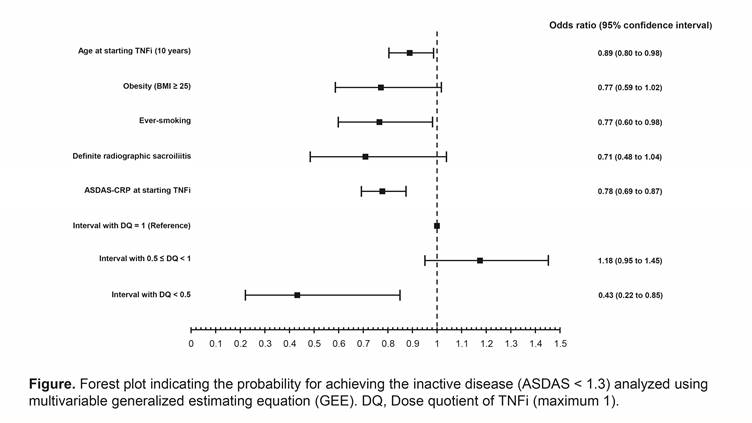Session Information
Date: Tuesday, October 23, 2018
Title: 5T112 ACR Abstract: Spondyloarthritis Incl PsA–Clinical V: Tx of PsA & Peripheral SpA (2886–2891)
Session Type: ACR Concurrent Abstract Session
Session Time: 4:30PM-6:00PM
Background/Purpose: Although recent treatment guideline of axial spondyloarthritis (axSpA) by the European League Against Rheumatism (EULAR) recommended that tapering of tumor necrosis factor inhibitor (TNFi) can be considered if a patient is in sustained remission, its efficacy compared to standard TNFi treatment has not been thoroughly investigated. Furthermore, whether the tapering strategy would affect the probability of achieving the optimal treatment target as recommended by ¡®Treat-to-Target¡¯ strategy is also unknown.
Methods: This was a nationwide, prospective cohort study including 776 axSpA patients in South Korea who had been receiving TNFi for at least 1 year with a 3-year follow-up. The effect of the tapering strategy on longitudinal disease activity was analyzed 1) by comparison of two groups according to patient¡¯s mean dose quotient (DQ) of TNFi during the observation (individual level) and 2) by comparison of 1-year intervals stratified by corresponding DQ (time level). The primary outcome was achieving Ankylosing Spondylitis Disease Activity Score (ASDAS) inactive disease (ASDAS-CRP less than 1.3) in 1-year interval. The relationship between the dosing strategy and the primary outcome was analyzed using generalized estimating equations (GEE).
Results: A total of 776 patients, with an observation period of 1576 person-years were analyzed. Patients¡¯ mean (SD) age was 37.8 (12.5) years and 605 (78.0%) of them were male. HLA-B27 was positive in 644 (92.0%) patients. Overall, 454 patients had maintained the standard dose of TNFi during the follow up (control group), and 322 patients were exposed to at least one episode of tapering (tapering group).
Mean (SD) ASDAS-CRP at baseline in the control and tapering groups were 3.6 (1.0) and 3.6 (1.1), respectively. ASDAS inactive disease was achieved in 665 (42.3%) intervals and the probability of achieving the target was not changed according to the follow-up periods. At the individual level, longitudinal changes in ASDAS-CRP in both groups were comparable during the observation period (beta = 0.05 [95% confidence interval -0.11 to 0.20]). This result was consistent at the time level; a 1-year interval with reduced DQ showed comparable odds for achieving the treatment target in corresponding intervals (adjusted OR 1.09 [0.89 to 1.33]). However, after further stratification of reduced DQs based on the intervals with DQ less than 0.5, those with DQ less than 0.5 were associated with decreased odds for achieving the optimal target (adjusted OR 0.43 [0.22 to 0.85]) (Figure). Meanwhile, drug survival between the two groups was comparable.
Conclusion: Tapering (but not by less than 0.5 of DQ) of TNFi showed a comparable efficacy to standard-dose TNFi treatment in achieving the optimal target in axSpA patients who had received TNFi for more than a year.
To cite this abstract in AMA style:
Park JW, Kim MJ, Kim HA, Shin K, Park YB, Song YW, Lee EY. Effect of Tapering of Tumor Necrosis Factor Inhibitor on Achieving Inactive Disease in Axial Spondyloarthritis Based on the ‘Treat-to-Target’ Strategy: A Nationwide Prospective Cohort Study [abstract]. Arthritis Rheumatol. 2018; 70 (suppl 9). https://acrabstracts.org/abstract/effect-of-tapering-of-tumor-necrosis-factor-inhibitor-on-achieving-inactive-disease-in-axial-spondyloarthritis-based-on-the-treat-to-target-strategy-a-nationwide-prospective-cohort/. Accessed .« Back to 2018 ACR/ARHP Annual Meeting
ACR Meeting Abstracts - https://acrabstracts.org/abstract/effect-of-tapering-of-tumor-necrosis-factor-inhibitor-on-achieving-inactive-disease-in-axial-spondyloarthritis-based-on-the-treat-to-target-strategy-a-nationwide-prospective-cohort/

